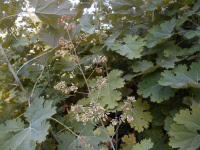Description
An imposing plant – impressive, glaucous leaves with conspicuous veins and jagged margins, and, from July to October, tawny pink plumes.
Can not ship to: Delaware and Maryland
An imposing plant – impressive, glaucous leaves with conspicuous veins and jagged margins, and, from July to October, tawny pink plumes.
An imposing plant – impressive, glaucous leaves with conspicuous veins and jagged margins, and, from July to October, tawny pink plumes.
Can not ship to: Delaware and Maryland
OUT OF STOCK
Green flowers in summer then, “conspicuous in winter when covered with its grayish white fruits which stay on the branches until spring.” Bailey “The leaves turn a fine brown-purple in the fall, but the berries are the thing – pewter in color, with a texture like those Fourth of July sparklers of childhood memory, they have a delicious fragrance.” Allen Lacy.
Size: 9’ x 10’
Care: sun in any soil
Native: Canada to Southeastern U.S. No pruning needed but can be pruned at any time of year, if desired.
Wildlife Value: Berries relished by chickadees, red-bellied woodpeckers, swallows, Titmouse, catbirds, bluebirds, Northern flicker & yellow-rumped warblers. Bayberry thickets also provide nesting sites for songbirds, offering excellent protection from predators.
Probably 1st collected for gardens by John Bartram (1699-1776). Offered for sale in Bartram Garden’s 1783 Broadside, America’s 1st plant catalog. In 1800’s considered “very ornamental in the shrubbery.” Fragrant leaves used for potpourri, abundant berries used to make candles. Good road-side plant, salt tolerant. Berries used to make candles. Boil berries (drupes) to melt wax coating. Collect wax from surface of water. In American Medicinal Plants Charles F. Millspaugh noted that “Candles made from this wax, though quite brittle, are less greasy in warm weather, of fine appearance, slightly aromatic, and smokeless after snuffing, rendering them much more pleasant to use than those made of either wax (paraffin) or tallow (animal fat).” 1892.
Small purple flowers atop tall leafless stems from July to October. Great see-through blooms for growing in back, middle or front of the garden.
Size: 3-4’ x 8”
Care: full sun in moist, well-drained, fertile soil - self-seeder
Native: South America
Awards: Royal Horticultural Society Award of Merit & Missouri Botanic Garden Plant of Merit.
Introduced to garden cultivation from its native Buenos Aires in 1726 by the Sherard brothers.
Fast-growing, pyramidal-shaped deciduous conifer. The orange to brown trunk base tapers and thickens with up to a dozen large buttress-like root flares extending several feet up the trunk. Feathery, fern-like, soft foliage emerges light green in spring, and turns red-bronze in fall before dropping. Its branches are well-attached and make excellent climbing.
Size: 70-90’ x 15-25’
Care: sun in moist to moist well-drained, slightly acid soil
Native: Szechuan China
Awards: Royal Botanic Garden Award of Garden Merit, Yew Dell Botanical Gardens’ Theodore Klein Plant Awards & Pennsylvania Horticultural Society Gold
From fossil records, dawn redwood is known to have existed as many as 50,000,000 years ago. However, it was not until 1941 that dawn redwood was first discovered growing in the wild near the town of Modaoqi China by Chinese forester, T. Kan. Seeds collected from the original site were made available to the Missouri Botanical Garden in 1947. Seedlings grown therefrom were planted in front of the Lehmann Building at MBG in 1952 where they have now developed into large mature trees (70’+ tall). Dawn redwood is a deciduous, coniferous tree that grows in a conical shape to 100’ tall. It is related to and closely resembles bald cypress (Taxodium) and redwood (Sequoia).
Small crimson-red bells dangle from July to September
Size: 8’ x 3’
Care: Sun in humusy, fertile, moist well-drained soil. Mulch around the base. Flowers on current year’s stems so cut back to 6-9” in late winter or early spring.
The genus Clematis was named by Dioscordes, physician in Nero’s army, from “klema” meaning climbing plant. The species 1st collected by the “Father of Texas botany,” Ferdinand Lindheimer in 1830’s. Max Leichtin of the Baden Garden sent Clematis texensis to Kew Botanic Garden near London in 1880’s. French nurseryman Francisque Morel sent this selection to William Robinson who named it for his English nursery at Gravetye Manor in 1914.

